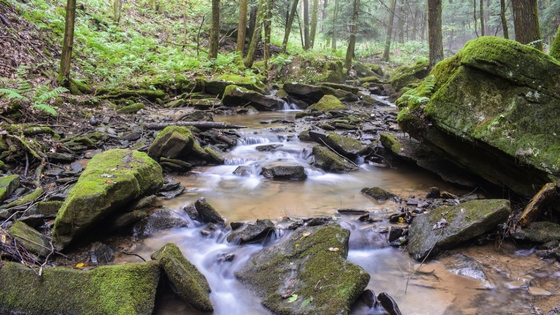Brook Trout Habitat

 Small native Brook Trout stream in Pennsylvania
Small native Brook Trout stream in Pennsylvania
Brook Trout live in rivers and streams in cold, clear water that’s well-oxygenated.
Much of its native distribution is known for is cold, clear water, which now makes up much of Ontario, Quebec, New York, Pennsylvania, Ohio, Maine, Vermont, New Hampshire and Illinois to name a few states and provinces.
Ideal habitat for the Brook Trout is a permanently cold, clear, spring-fed water where there’s plenty of cover, overhanging branches, logs and is free from human construction or agriculture.
This excludes much of the industrial and populous southern parts of the Canada including Ontario and Quebec and the north eastern United States.
Cold Water Dwellers
In most cases Brook Trout are not found in water that exceeds 68°F/20°C. If water goes above that, they’ll head deeper in to pool and rifts in rivers and deeper into lakes and ponds.
Several years ago, the Texas department of Parks and Wildlife tried to introduce the Brook Trout to the Guadeloupe river. As we’d expect none of the fish survived. While winters have cold, clear water, summers are just far too warm.
While they can tolerate temperatures just above 68°F/20°C, they can’t survive in it for long periods of time, which is why they thrive in northern Ontario and Quebec rivers that dump into Hudson’s Bay and James Bay.
Stream and River Habitat
Streams that are fast moving but have quiet pools and riffles and most preferred by Brook Trout. Many rivers and streams that dump into James Bay and Hudson’s Bay offer these ideal conditions and never get above 68°F/20°C.
Fast moving rivers offer an abundant supply of oxygen. Slow moving bodies of water with little oxygen will not support Brook Trout. The salinity of James Bay is very low due to the number of rivers and streams running off into the water.
In fact, satellite images of James Bay show the high level of silt entering the Bay from the numerous rivers.
Since 1979, the warming climate has resulted in much more water flowing into the bay, further reducing salinity and threatening other native species of James and Hudson’s Bay.
However there is a Mega Project that would change the nature of the habitat if it’s ever approved and the initiative was called the Grand Canal.
Grand Canal
In 1959, Thomas Kierans proposed damming James Bay and creating a canal to Lake Huron to provide North America with much needed water. The project was expected to cost $100 billion in 1990, but never moved past theory.
Environmental studies were planned but never carried out. Several reasons led to the proposal being shelved in clouding politics. Fear of loss of Canadian sovereignty and the high cost.
Habitat Destruction
The distinct trend of upstream movement in summer may be due to high temperature but exact evidence on this point is lacking. The brook trout will spawn wherever suitable spawning grounds exist and do not necessarily move upstream for this purpose.
Brook trout which spend their time along the shore of Lake Superior are called “coasters”.
If the environment changes, Brook Trout are not able to adapt and become vacant from the area. As such, many regions that had Brook Trout have since become irradiated by human influences from construction to dumping of effluent.
Other causes of their removal from their native regions is mining, agriculture and forestry. But the damage didn’t stop there. Pollution from the air and water have also cut down their numbers. While they’re not on the endangered list yet, they are a species to watch.
In addition to chemical pollution and algae growth caused by runoff containing chemicals and fertilizers, air pollution is a significant factor in the disappearance of brook trout from their native habitats.
Brook trout populations across large parts of eastern Canada have been similarly challenged and a subspecies known as the aurora trout was extirpated from the wild by the effects of acid rain.
Today, in many parts of the range efforts are underway to restore Brook Trout to those waters that once held native populations. Stocking of other trout species only in habitats that can no longer be recovered sufficiently to sustain brook trout populations.


